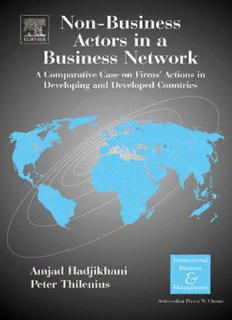
Non-Business Actors in a Business Network: A Comparative Case on Firms' actions in Developing and Developed Countries (International Business and Management) (International Business and Management) PDF
Preview Non-Business Actors in a Business Network: A Comparative Case on Firms' actions in Developing and Developed Countries (International Business and Management) (International Business and Management)
NON-BUSINESS ACTORS IN A BUSINESS NETWORK INTERNATIONALBUSINESSANDMANAGEMENTSERIES SeriesEditor:PervezN.Ghauri Published GHAURI&OXELHEIM EuropeanUnionandtheRaceforForeignDirectInvestmentinEurope HYDER&ABRAHA StrategicAlliancesinEasternandCentralEurope CONTRACTOR&LORANGE AlliancesandCo-operativeStrategies GEMÜNDEN,RITTER&WALTER RelationshipsandNetworksinInternationalMarkets GHAURI&USUNIER InternationalBusinessNegotiations HAVILA,FORSGREN&HÅKANSSON CriticalPerspectivesonInternationalisation MOROSINI ManagingCulturalDifferences NAUDE&TURNBULL NetworkDynamicsinInternationalMarketing BUCKLEY&GHAURI TheGlobalChallengeforMultinationalEnterprises HÅKANSSON&JOHANSON BusinessNetworkLearning LI ManagingInternationalBusinessVenturesinChina YANG IntellectualPropertyandDoingBusinessinChina Forthcomingtitles HENNART&THOMAS GlobalCompetitiveStrategies Othertitlesofinterest FATEMI InternationalTradeinthe21stCentury DUNNING Globalization,TradeandForeignDirectInvestment MONCARZ InternationalTradeandtheNewEconomicOrder KREININ ContemporaryIssuesinCommercialPolicy Relatedjournals–samplecopiesavailableonrequest EuropeanManagementJournal InternationalBusinessReview InternationalJournalofResearchinMarketing LongRangePlanning ScandinavianJournalofManagement ForfulldetailsofallIBMtitlespublishedundertheElsevierimprintpleasegoto: http://www.elsevier.com/locate/series/ibm NON-BUSINESS ACTORS IN A BUSINESS NETWORK A COMPARATIVE CASE ON FIRMS’ ACTIONS IN DEVELOPING AND DEVELOPED COUNTRIES BY AMJAD HADJIKHANI UppsalaUniversity,Sweden and PETER THILENIUS MälardalenUniversity,Sweden 2005 Amsterdam–Boston–Heidelberg–London–NewYork–Oxford Paris–SanDiego–SanFrancisco–Singapore–Sydney–Tokyo ELSEVIERB.V. ELSEVIERInc. ELSEVIERLtd ELSEVIERLtd SaraBurgerhartstraat25 525BStreet,Suite1900 TheBoulevard,Langford 84TheobaldsRoad P.O.Box211 SanDiego Lane,Kidlington London 1000AEAmsterdam CA92101-4495 OxfordOX51GB WC1X8RR TheNetherlands USA UK UK ©2005ElsevierLtd.Allrightsreserved. ThisworkisprotectedundercopyrightbyElsevierLtd,andthefollowingtermsandconditionsapplytoitsuse: Photocopying Singlephotocopiesofsinglechaptersmaybemadeforpersonaluseasallowedbynationalcopyrightlaws.Permissionofthe Publisherandpaymentofafeeisrequiredforallotherphotocopying,includingmultipleorsystematiccopying,copyingfor advertisingorpromotionalpurposes,resale,andallformsofdocumentdelivery.Specialratesareavailableforeducational institutionsthatwishtomakephotocopiesfornon-profiteducationalclassroomuse. PermissionsmaybesoughtdirectlyfromElsevier’sRightsDepartmentinOxford,UK;phone:(+44)1865843830,fax: (+44)1865853333,e-mail:permissions@elsevier.com.Requestsmayalsobecompletedon-lineviatheElsevierhomepage (http://www.elsevier.com/locate/permissions). IntheUSA,usersmayclearpermissionsandmakepaymentsthroughtheCopyrightClearanceCenter,Inc.,222Rosewood Drive,Danvers,MA01923,USA;phone:(+1)(978)7508400,fax:(+1)(978)7504744,andintheUKthroughtheCopyright LicensingAgencyRapidClearanceService(CLARCS),90TottenhamCourtRoad,LondonW1P0LP,UK;phone:(+44)20 76315555;fax:(+44)2076315500.Othercountriesmayhavealocalreprographicrightsagencyforpayments. DerivativeWorks Tablesofcontentsmaybereproducedforinternalcirculation,butpermissionofthePublisherisrequiredforexternalresale ordistributionofsuchmaterial.PermissionofthePublisherisrequiredforallotherderivativeworks,includingcompilations andtranslations. ElectronicStorageorUsage PermissionofthePublisherisrequiredtostoreoruseelectronicallyanymaterialcontainedinthiswork,includinganychapter orpartofachapter. Exceptasoutlinedabove,nopartofthisworkmaybereproduced,storedinaretrievalsystemortransmittedinanyformorby anymeans,electronic,mechanical,photocopying,recordingorotherwise,withoutpriorwrittenpermissionofthePublisher. Addresspermissionsrequeststo:Elsevier’sRightsDepartment,atthefaxande-mailaddressesnotedabove. Notice NoresponsibilityisassumedbythePublisherforanyinjuryand/ordamagetopersonsorpropertyasamatterofproducts liability,negligenceorotherwise,orfromanyuseoroperationofanymethods,products,instructionsorideascontainedinthe materialherein.Becauseofrapidadvancesinthemedicalsciences,inparticular,independentverificationofdiagnosesand drugdosagesshouldbemade. Firstedition2005 LibraryofCongressCataloginginPublicationData AcatalogrecordisavailablefromtheLibraryofCongress. BritishLibraryCataloguinginPublicationData AcataloguerecordisavailablefromtheBritishLibrary. ISBN:0-08-044615-9 ∞(cid:2)ThepaperusedinthispublicationmeetstherequirementsofANSI/NISOZ39.48-1992(PermanenceofPaper).Printedin TheNetherlands. Contents Preface vii Part1:TheoreticalandEmpiricalFields 1. BusinessFirms’InteractionwiththeEnvironment 3 2. BusinessNetworksandNon-BusinessActors’Embeddedness 21 Part2:DecompositionoftheFacts 3. TheFocalRelationship 39 4. Adaptation 65 5. SocialInteraction 89 6. Embeddedness 115 Part3:Synopsis 7. RelationshipandEmbeddedness 153 8. Results 177 9. ConcludingRemarks 193 References 217 This Page Intentionally Left Blank Preface Althoughwearetheauthorsofthistext,wecannotclaimautonomyinitscreation. Wehavereceivedcontributionsfromvarioussources,andwithoutthese,thework would have been impossible to accomplish. The research would not have been possible without the support received from the Swedish Research Council. The group engaged in the research on the Middle East has given their wholehearted supportandassistanceduringtheyearsneededtocompletethistask.Wearealso indebted to other groups that have assisted our work and without whose help the research could not have been undertaken. We are grateful for the enormous assistance received from the Industrial Management Institute (IMI) in Iran. The formerManagingDirector,Dr.Ja’farMara’shi,’andtheresearchers,Dr.Mortezah Emadzadeh,AliAyari,MansourMojaddam,andFirozehSaber,workedtirelessly when conducting the survey in Iran. It was only through the input of the IMI researchgroupthatthedatacollectioninIranbecamepossible.Theempiricalpart ofthestudyalsoreceivedagreatdealofhelpfromresearcherFrancescoCiabuschi. Hisinputwastoassistinthesystemizationofthestatisticalmeasuresobtainedin the Iranian study and in the Industrial Marketing and Purchasing (IMP2) study. Throughoutthewritingofthisbook,ProfessorJanJohansonprovidedaconstant streamofencouragementandconstructivesuggestions.ThesupportofProfessors Bo Utas and Annika Rabo sustained our spirits and expanded our thinking. We arealsoingreatdebttoDr.JavadAmid,whosereflectionsandinsightsappearin differentpartsofthisbook. AmjadHadjikhaniandPeterThilenius Uppsala,September2004 This Page Intentionally Left Blank Part 1 Theoretical and Empirical Fields The authors of the book “Managing Business Relationships” (Ford et al. 1998), whichdiscussesthebusinessnetwork,beginwiththestatementthat“Nobusiness exists in isolation. Each business is dependent for its survival on customers and suppliersofproductsandservices,financeandadvice...theycooperatetoreceive or supply products; ... lobby the government for better trading conditions.” So far, so good: The statement acknowledges the existence of other actors, such as governments, that interact with the commercial actors. The authors have made a great job of developing concepts and presenting managerial implications, but whenthebookwasstudiedmoreclosely,itwasrealizedthatthestatementabove on government loses its significance if the factor of non-business actors is left untouched. Except for a few later studies, this is a common omission among studiesthatapplyindustrialnetworktheoryorothermarketingdisciplines.Earlier researcherstendedtoanalyzemarketingasasinglebuyingorsellingtransaction. Themarketingmixmodelinitiallydirecteditsfocusatsuppliers,andlateratthe industrialrelationship(see,forexample,Kotleretal.1996).AswithFordetal.’s researchonindustrialnetworks,thesestudiesleavethenon-businessactorsinthe contextof“theenvironment”andtreatthemasthoughconstrainingfactorshave someinfluence. This brief review shows that there is a gap in marketing research that calls fornewstudieswhichpayattentiontotheinteractionbetweenbusinessandnon- businessactors.Theaimofthisstudyhasbeentodevelopaconceptualframework foruseinanalyzingtheempiricalfacts.Thismodelisconstructedonthetheory ofindustrialnetworks,whichidentifiesactors,activities,andresources. Thereisalargeamountofresearchthatstudiesmarketingfromthepointofthe viewofmultinationalcompanies(MNCs).Basedonempiricalevidenceaboutthe behaviorofMNCs,conclusionsaredrawnwithoutanyreferencetothebehaviorof theirlocalpartners.ThebehavioroftheMNCsisnotcoupledwithopportunities open to the local firms. In reaction to this shortcoming, this study goes against
Description: